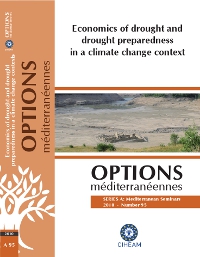| Article précédent | p. 329-334 | Article suivant |
Adopting intercropping system for potatoes as practice on drought mitigation under Tunisian conditions
The adoption of intercropping systems in the irrigated perimeters can constitute an agronomic way to increase the added value by used m3 of water. The objective of this research was to evaluate the efficacy of intercropping potatoes with green bean compared to monoculture potatoes. Intercropped potatoes showed no significant reduction in yield when compared to monoculture potatoes. Green beans yields were reduced when concurrently intercropped. The relative yield total (RYT), a measure of intercropping productivity, was 1.55 indicating that it would require 55 percent more land for separate monoculture plantings of potatoes and beans to produce a yield equivalent to the intercropping system. On the other hand, the intercropping system engendered an increase in the water and in the radiation use efficiencies (WUEMST and RUEMST) from 8.69 kg/m3 to 10.15 kg/m3 and from 4.47 g/MJ to 4.77 g/MJ, respectively. Finally, a linear relation between the accumulated absorbed radiation and the accumulated evapotranspiration was able to be revealed. Intercropping potatoes with green beans increases output per unit area and enables growers to take full advantage of the available natural resources.
L'adoption de systèmes de cultures intercalaires dans les périmètres irrigués peut constituer une forme agronomique permettant d'augmenter la valeur ajoutée par m3 d'eau utilisée. L'objectif de cette étude est d'évaluer l'efficacité d'intercaler des pommes de terres avec des haricots verts, comparée aux pommes de terre en monoculture. Les pommes de terre intercalées n'ont montré aucune réduction significative de rendement par rapport aux pommes de terre en monoculture. Le rendement des haricots verts a été réduit lorsqu'il était concurrencé par la culture intercalée. Le rendement relatif total (RYT), une mesure de la productivité en culture intercalaire, était de 1,55, ce qui signifie qu'en monoculture séparée de pommes de terre et de haricots verts il faudrait 55 pour cent de terre en plus pour atteindre un rendement équivalent à celui du système intercalaire. D'autre part, le système intercalaire a entraîné une augmentation de l'efficacité d'utilisation de l'eau et du rayonnement (WUEMST et RUEMST) qui est passée respectivement de 8,69 kg m-3 à 10,15 kg m-3 et de 4,47 g MJ-1 à 4,77 g MJ-1. Finalement, une relation linéaire a pu être révélée entre le rayonnement absorbé accumulé et l'évapotranspiration accumulée. Les pommes de terre intercalées avec les haricots verts ont permis d'augmenter la production par unité de surface, et ainsi les cultivateurs ont pu valoriser pleinement les ressources naturelles disponibles.
- [ Afficher ]
- [ Télécharger ]
- [ Exporter la citation ]
Vous pouvez télécharger la citation au format :
- [ Imprimer ]
-
Mots-clés
CULTURE INTERCALAIRE, EFFICACITE D'UTILISATION, EFFICIENCE D'UTILISATION DE L'EAU, HARICOT COMMUN, PHASEOLUS VULGARIS, POMME DE TERRE, RADIATION SOLAIRE, RENDEMENT DES CULTURES, SECHERESSE, SOLANUM TUBEROSUMCiter cet article
Rezig M., Sahli A., Ben Jeddi F., Harbaoui Y. Adopting intercropping system for potatoes as practice on drought mitigation under Tunisian conditions. In : López-Francos A. (comp.), López-Francos A. (collab.). Economics of drought and drought preparedness in a climate change context. Zaragoza : CIHEAM / FAO / ICARDA / GDAR / CEIGRAM / MARM, 2010. p. 329-334. (Options Méditerranéennes : Série A. Séminaires Méditerranéens; n. 95). 2. International Conference on Drought Management, 2010/03/04-06, Istanbul (Turkey). http://om.ciheam.org/om/pdf/a95/00801365.pdf



